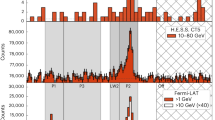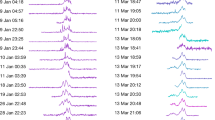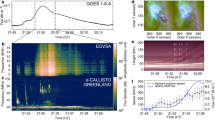Abstract
ONE of us (P. A. S.) has recently proposed a model of pulsars, the properties of which were compared with the known radio, optical and X-ray emission from the Crab pulsar1. We now wish to point out that the model predicts a high-frequency modulation of the optical, X-ray and γ-ray radiation which might be detected in the optical part of the spectrum.
This is a preview of subscription content, access via your institution
Access options
Subscribe to this journal
Receive 51 print issues and online access
$199.00 per year
only $3.90 per issue
Buy this article
- Purchase on Springer Link
- Instant access to full article PDF
Prices may be subject to local taxes which are calculated during checkout
Similar content being viewed by others
References
Sturrock, P. A., Nature, 227, 465 (1970).
Wampler, E. J., Scargle, J. D., and Miller, J. S., Astrophys. J. Lett., 157, L1 (1969).
Parzen, E., Stochastic Processes, 117 (Holden-Day, San Francisco, 1962).
Author information
Authors and Affiliations
Rights and permissions
About this article
Cite this article
STURROCK, P., BRACEWELL, R. & SWITZER, P. Possible High-frequency Modulation of Light from the Crab Pulsar. Nature 229, 186–187 (1971). https://doi.org/10.1038/229186a0
Received:
Issue Date:
DOI: https://doi.org/10.1038/229186a0
This article is cited by
Comments
By submitting a comment you agree to abide by our Terms and Community Guidelines. If you find something abusive or that does not comply with our terms or guidelines please flag it as inappropriate.



